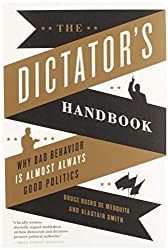
Rating: 7.7/10.
Summary
Why do dictators consistently become terrible instead of doing what’s best for their country? This book explains the rules that govern dictatorships: using selectorate theory (proposed by the authors), they explain how incentives in dictatorships naturally tend toward a stable equilibrium that’s bad for most of its inhabitants, but democracies tend towards a good equilibrium.
The primary trait of dictatorships is the government is run by a small number of people (a coalition). No leader can hold power by himself, but when the leader has the support of the coalition, he has control over the whole country, no matter what the rest of the population thinks about him. When the coalition is small, the rational thing to do is give as much money as possible to your supporters so they continue to support you (instead of supporting somebody else who will give them the maximal amount of money). In a democracy, the coalition is a lot bigger, so the leader has no way of rewarding a few supporters at the expense of the masses.
It doesn’t take much skill to be a dictator, your main job is find the money and pay your supporters so you can remain in power. Getting money is easier when your country has natural resources, otherwise you can take national debt or take foreign aid (money transfer to dictators in exchange for implementing policies that the donor wants). Taxation is cumbersome to administer properly, so it’s easier to allow officials to partake in corruption as a form of implicit tax.
Several things threaten the stability of a dictatorship: running out of money to pay supporters is a big fear, and death of a ruler also leaves a gap to fight over. Dictatorships can fail early if the ruler is unable to find the money quickly, but once they’re past this stage, dictators tend to remain in power much longer than democratic leaders. Discontentment in the population is not a real threat to the regime as long as the army is paid enough to clamp down on uprisings.
Criticisms
The authors conveniently assume a dichotomy between dictatorships and democracies, and in every example, they contrast a democracy doing something good vs a dictatorship doing something terrible. They only cherry-pick evidence that supports their position, ignoring problematic democracies like India (which they consider to be a democracy but fails to deliver a high standard of living), and China (which is not a democracy but has some impressive achievements). In reality, there’s a large amount of variation in different democracies and dictatorships, so such a simple dichotomy is unconvincing.
The book is also vague about who exactly is included in the winning coalition. A coalition is defined as the people whose support you need to control a country, but how big is this group? The authors never address this explicitly, but imply that it’s a small group that the ruler has personal connections with — army generals and high-ranking officials, so probably no more than a few dozen. This doesn’t make sense to me, just as a dictator can’t rule by himself, an army general similarly needs thousands of soldiers to do anything. So it’s unclear whether these soldiers should belong in this coalition.
Overall, the book gives an extremely cynical view of politics: any action by the leader is a ploy to maximize his own power and material gain; policies that appear to be well-intentioned universally have selfish underlying motives. I don’t think adopting such a pessimistic view of human nature is necessary to explain politics. Still, assuming the theories are partially true, they provide a good explanation of some recurring phenomena like the resource curse (countries with rich natural resources tend to become poor and oppressive).



